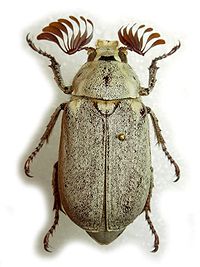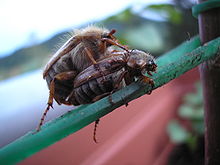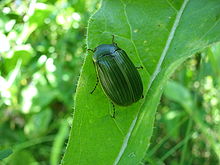- Melolonthinae
-
Melolonthinae 
Male Polyphylla alba specimen
(Melolonthini)Scientific classification Kingdom: Animalia Phylum: Arthropoda Class: Insecta Order: Coleoptera Superfamily: Scarabaeoidea Family: Scarabaeidae Subfamily: Melolonthinae
Samouelle, 1819Diversity About 20-30 tribes Synonyms Hopliinae
Systellopodinae Mating Rhizotrogon marginipes (Melolonthini/Rhizotrogini), male on top – note sexually dimorphic antennae
Mating Rhizotrogon marginipes (Melolonthini/Rhizotrogini), male on top – note sexually dimorphic antennae
Melolonthinae is a subfamily of the scarab beetles (family Scarabaeidae). It is a very diverse group; distributed over most of the world, it contains many familiar species. Some authors include the scarab subfamilies Euchirinae and Pachypodinae as tribes in the Melolonthinae.
Unlike some of their relatives, their habitus is usually not bizarre. They resemble the Rutelinae in being fairly plesiomorphic in outward appearance. Like in many Scarabaeidae, males have large fingered antennae, while those of the females are small and somewhat knobby. In the Melolonthinae, this sexual dimorphism is particularly pronounced. Many species have striking – though rarely brilliant or iridescent – hues and bold patterns of hairs.
Being often quite sizeable and swarming in numbers at certain times, for example the Amphimallon, Phyllophaga and Polyphylla "june beetles" or the Melolontha cockchafers – all from tribe Melolonthini – feature widely in folklore. Some Melolonthinae are economically significant pests. Other than the Melolonthini, the most diverse tribes are the Ablaberini, Liparetrini, Macrodactylini, Pachydemini and Sericini.
Systematics
According to various authors, the living Melolonthinae are divided into about 20-30 tribes. Some notable genera and species are also listed here:
- Ablaberini Burmeister, 1855 – including Camentini
- Automoliini Britton, 1978
- Chasmatopterini Lacordaire, 1856
- Colymbomorphini – sometimes in Xylonychini
- Comophorinini Britton, 1957 – including Comophini
- Diphucephalini Britton, 1957
- Diphycerini – sometimes in Macrodactylini
- Diplotaxini – sometimes in Melolonthini
- Heteronychini Britton, 1957
- Hopliini
- Lichniini
- Liparetrini Burmeister, 1855 – including Allarini, Colpochilini
- Macrodactylini Kirby, 1837[verification needed] – including Dichelonyciini
- Maechidiini Burmeister, 1855
- Melolonthini Samouelle, 1819[verification needed]
- Amphimallon
- Amphimallon solstitialis – Summer Chafer, European June Beetle
- Melolontha – cockchafers, May bugs
- Phyllophaga – May beetles
- Polyphylla
- Amphimallon
- Oncerini
- Pachydemini Reitter, 1902
- Pachytrichini Burmeister, 1855
- Phyllotocidiini Britton, 1957
- Podolasiini – sometimes in Hopliini
- Rhizotrogini – sometimes in Melolonthini
- Scitalini Britton, 1957
- Sericini Dalla Torre, 1912
- Maladera
- Maladera insanabilis – Khomeini Beetle
- Maladera
- Sericoidini Burmeister, 1855
- Stethaspini – sometimes in Xylonychini
- Systellopini Sharp, 1877
- Tanyproctini – sometimes in Pachydemini
- Xylonychini Britton, 1957
In addition, a prehistoric tribe, the Cretomelolonthini, is only known from fossils.
Several genera are of unclear relations; they are not yet firmly placed in a tribe:
- Acoma
- Conebius Fuavel, 1903
- Costelytra – Liparetrini?
- Hemictenius – Pachydemini?
- Lacris Fairmaire & Germaine, 1860
- Metascelis Westwood, 1842
- Mycernus – Colymbomorphini, Stethaspini, Xylonychini?
- Odontria – Liparetrini?
- Prodontria – Liparetrini?
- Podolasia Harold, 1869 (= Lasiopus Dejean 1833 (non Schoenherr, 1823: preoccupied))
- Psilodontria – Colymbomorphini, Stethaspini, Xylonychini?
- Scythrodes – Liparetrini?
- Sericospilus – Liparetrini?
"Anonetus" and "Tryssus", both used by Erichson in 1847, are nomina nuda. Holophylla and Hoplorida are of uncertain validity.
Whether the scarab beetle Xenaclopus belongs in the present subfamily is doubtful. Alosimus, generally held to be a blister beetle of the Lyttini and not at all close to the scarabs, was placed in the Melolonthinae by entomologist Werner Heinz Muche.
References
 Data related to Melolonthinae at Wikispecies
Data related to Melolonthinae at Wikispecies  Media related to Melolonthinae at Wikimedia Commons
Media related to Melolonthinae at Wikimedia CommonsThis Scarabaeidae-related article is a stub. You can help Wikipedia by expanding it.


